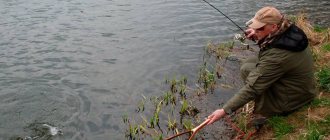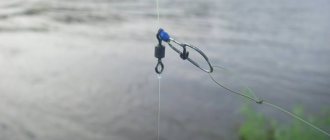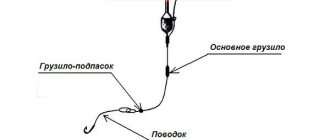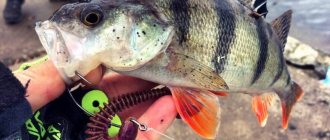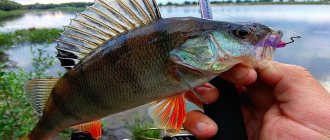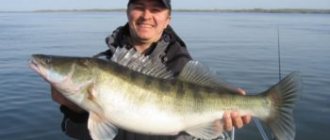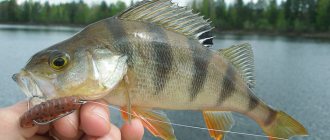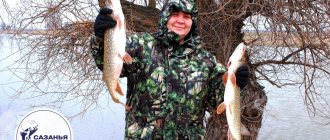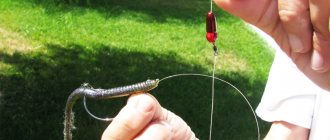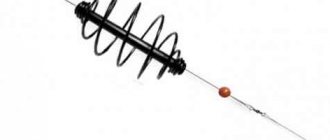What is it and where is it used?
“Diversion” allows you to bait with different animations on reservoirs with still water and on the current.
The design of a retractable leash is not complicated - a leash of the selected length is attached to a fishing line with a sinker attached at the end at a certain distance from the sinker. A simple installation scheme at first glance suggests numerous ways to implement it, which provide innumerable options for catching predatory, semi-predatory and even some peaceful fish.
By selecting the weight of the sinker, the length of the leash, and the method of retrieving, you can present the bait so that any fish interested in animal food will not remain indifferent to it, but the best option for using a diverter is bottom fishing for large specimens:
- perch;
- bersha;
- pike perch;
- pike.
Advantages of a retractable leash:
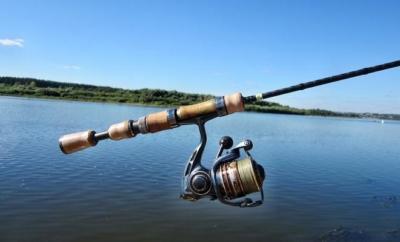
- High catchability.
- Possibility of long casting.
- Variability of installation and wiring.
- Fishing at different water levels.
- Fishing in any body of water including:
- on reservoirs with complex bottom topography;
- on a fast current;
- in difficult places in thickets of aquatic vegetation and among snags, hiding the sting of an offset hook in the body of the bait;
- in reservoirs with rocky and shell bottoms, using a Tyrolean stick sinker.
- Fishing in any weather.
- Gear sensitivity.
- Installation is not difficult, any beginner can do it.
Disadvantages of a diverter leash:
- It's hard to find any flaws in this catchy tackle. The possibility of twisting the leads of the sinker and bait can be considered a disadvantage, but with sufficient experience, the leads will rarely overlap and twist.
- Slow retrieval is not suitable when fishing for active fish, but it can be compensated for by aggressive action of the bait.
How to fish with a retractable leash
The equipment is thrown into the required place. After the load touches the bottom, the wiring begins. Choosing leashes is a creative process. It is selected depending on the activity of the fish and its species composition. The line must always be taut.
- Dragging along the bottom. After the load has reached the bottom, we begin to reel in the equipment evenly and slowly. The weight will drag along the bottom, raise turbidity, knock, attracting fish, and the bait will go slightly behind parallel to the bottom. You can take short breaks.
- Dotted line animation. Retrieving, where the action of the bait is determined by the movements of the rod or by reeling in the reel, as in jig fishing. Two or three stretches up, pause. During the pause, the free line is selected by the reel. The number of stretches and the duration of pauses may vary.
- Aggressive jerking. Used for active, feeding fish. The movements are set by sudden movements of the rod. During the pause, you can make oscillating or trembling movements, which has a positive effect on perch bites.
If the rig is used when fishing in the current, then the rig should be exclusively with a leash sliding along the main line. Otherwise, on each cast the line will twist and intertwine. Cast at an angle of 50-70 degrees downstream.
Tackle
Rod
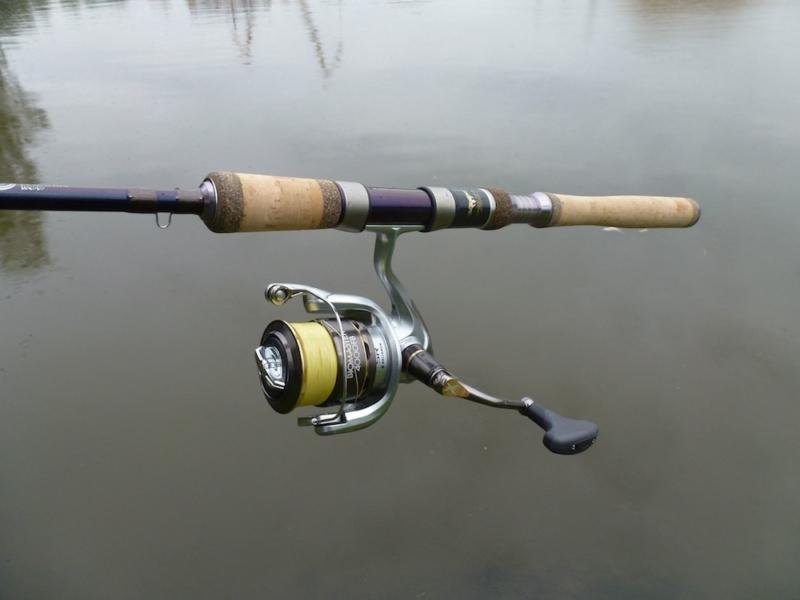
Choice is most often a search for a compromise between different requirements. When fishing with a retractable rod, it should provide active animation of baits combined with sufficient power.
Length
A long stick will not allow for controlled play of the bait ; a short one will not allow for long casting.
The optimal choice is a rod of 2.4-2.7 m.
Build
- Slow and medium action will not ensure proper play of the bait and will make long-distance casting difficult.
- An ultra-fast action will not allow you to control the movement of the fish when playing and will not provide a sharp hook.
For perch this is not so important, for pike, pike perch, and bersh it is important. Without a good hook, even a sharp hook will not penetrate their strong mouth.
Expert opinion
Knipovich Nikolai Mikhailovich
Zoologist, hydrobiologist. I am interested in fishing at a professional level.
For fishing on the outlet, choose a medium-fast system (moderate fast).
Test
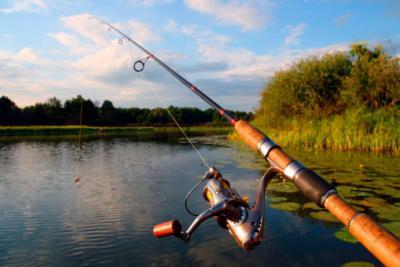
Depth, current strength, weight of the sinker are the main factors influencing the choice of this parameter.
- Universal, i.e. A spinning rod with a test of 7-40 is considered capable of handling most reservoirs that do not have beyond ordinary characteristics.
- On small bodies of water without a fast current, where there is no need to cast a heavy sinker long-distance, the choice can be made on “light” with a dough of up to 20 g.
- In large and deep reservoirs, the upper limit of the test can be 60 g.
We can recommend spinning rods that specialize in fishing with spaced rigs. These are the series:
- Maximus Legend-X for beginners;
- Maximus Black Widow for the more experienced.
These models have an optimal price-quality ratio.
Coil
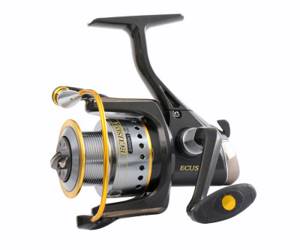
The reel is matched to the fishing rod; there are no specific requirements for it. The main requirement for the spool capacity is laying 120-150 m of fishing line of the required section. For braids 0.12-0.14, a 2000 coil is suitable .
Main line
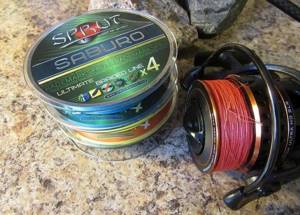
For off-line fishing, braided fishing line is used, which fully meets the requirements.
The cross-section of the fishing line is selected to match the maximum expected weight of the catch.
Sinker
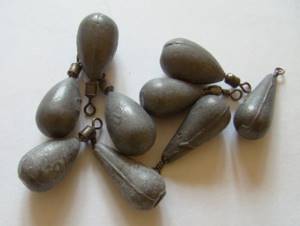
The sinker when fishing with a lead is the most important part of the equipment . The shape of the sinker determines the success of wiring in a particular body of water:
- A pond with difficult to pass places, overgrown with aquatic plants or snags, will require the use of a streamlined spindle-shaped or olive-shaped sinker.
- In a reservoir with a bottom covered with sharp stones or shell rock, you cannot do without the use of a “Tyrolean stick”. Such a sinker does not drag along the bottom, but seems to hover above it, preventing the leash from rubbing against sharp objects.
- For reservoirs with a clean bottom, sinkers of any shape are suitable.
- In a fast current, you need sinkers that hold well at the bottom - flat, with spikes, with wings.
Hook
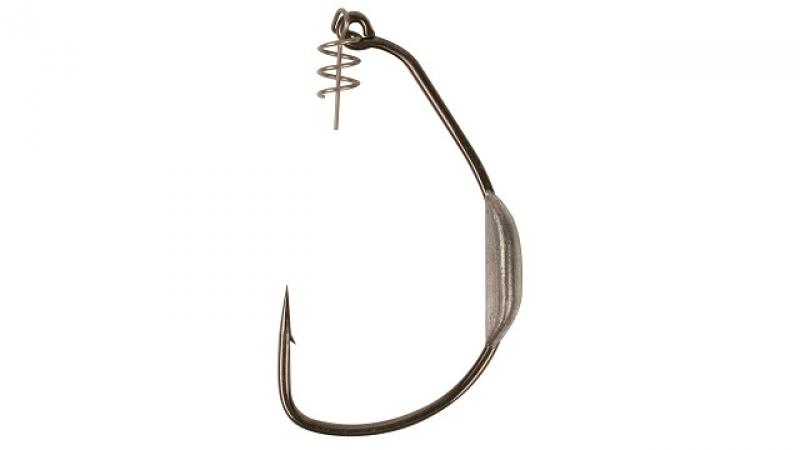
- Straight hooks are selected for clear water, where the likelihood of snagging is low.
- For difficult-to-pass places, offset hooks are chosen, the sting of which can be pressed against the body of the bait or hidden in it.
The hook size must match the size of the bait:
- For vibrotails and twisters, the hook is selected so that the sting comes out of the body of the bait approximately in the middle of the body.
- Slugs and short worms are placed with the head on the bend of a straight hook when fishing in clear water.
- In hard-to-reach places, slugs and worms are placed on an offset hook.
Expert opinion
Knipovich Nikolai Mikhailovich
Zoologist, hydrobiologist. I am interested in fishing at a professional level.
An angler should have a large collection of hooks in his fishing box. It is better not to conduct theoretical research on the correspondence of the hook number to the size of the bait, but simply select a hook from the collection.
Theoretically, hooks numbers 6-10 are suitable for perch.
Leashes
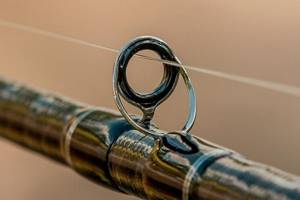
Using rigid fluorocarbon fishing line as bait leaders has undeniable advantages:
- rigid fluorocarbon line reduces the risk of overlapping and twisting of leads;
- fluorocarbon fishing line is invisible in the water, which is of great importance when presenting bait to wary fish;
- fluorocarbon does not lose its properties after prolonged use in water;
- Fluorocarbon is resistant to abrasion and sunlight.
Expert opinion
Knipovich Nikolai Mikhailovich
Zoologist, hydrobiologist. I am interested in fishing at a professional level.
A thick fluorocarbon leader 0.25-0.35 mm, along with the above-mentioned advantages, is likely to withstand the sharp teeth of a pike, i.e. it is more versatile than regular fishing line.
The leash must perform a safety function - to save the rest of the equipment from breaking in the event of a dead hook.
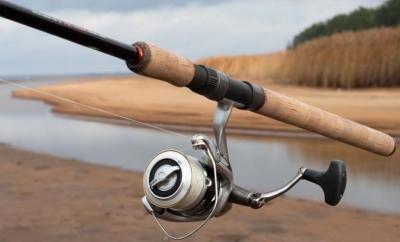
To do this, the breaking load of the leader line should be 10-15% less than the main one.
The leash for the sinker can be made of ordinary fishing line, the main thing is that it performs a safety function.
Leash length
- The bait leash, depending on the fishing conditions, is 60-150 cm.
- Weight leash – 30-50 cm.
How to choose a reel, line, hooks and sinkers
Coil
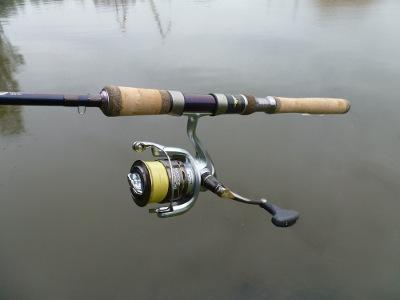
Basic requirements for a reel for cast fishing:
- good line laying on a jerky retrieve;
- ease;
- quality and reliability.
Main line
Monofilament or braided line can be used as the main line . Braid is definitely preferable. Its main advantage is its low elongation: thanks to this, the braid provides the gear with maximum sensitivity, transmitting to the spinning rod all the nuances of the bait and bite.
In addition, the braid has high tensile strength with a small diameter, which allows you to make long casts and comfortably fish in the current and wind.
Leash
To make the diverter leash itself, monofilament or fluorocarbon . The advantages of fluorocarbon are maximum invisibility in the water (it does not scare away fish) and resistance to abrasion on stones and shell rock.
Also, do not forget that when hunting for pike or catching perch, pike perch and any other predator in places where the probability of a toothy bite is very high, you must use a metal leash.
It significantly worsens the performance of the silicone bait and often reduces the number of bites, so be careful.
Read our article about how to tie a lead leash to the main line.
Hooks
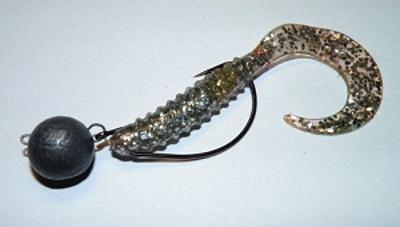
When fishing with a “retract” using jig baits, offset hooks are usually used. They are optimally suited for attaching silicone baits, while non-snacking mounts are made on the basis of offsets.
As you know, the problem with all spinning fishing methods that involve moving the bait among the bottom is frequent snags. The use of offset printers practically reduces it to nothing. Also, with non-clinging rigs, you can safely fish snags, grass thickets and other strong places.
The size of the offset hook must be selected primarily according to the size of the bait: the silicone fish must fit optimally on the hook. Also, when choosing an offset number, you need to take into account the size of the expected trophies.
In addition, if desired, when fishing with a retractable leash, you can use simple single hooks, as well as doubles and tees.
Cargo
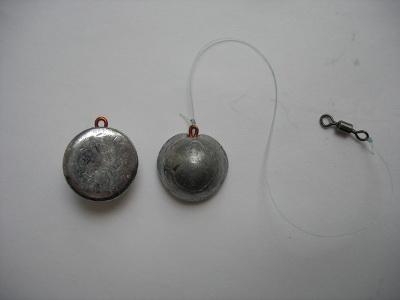
When selecting a load for fishing with a retractable leash, you need to pay attention to two parameters:
- weight;
- form.
The easiest way to select the weight of the sinker for catch fishing is to choose a weight that is 2-3 times greater than the weight of the jig head that would be required for fishing at a given point. In this case, the sinker, which is used for fishing with a retractable leash, will drop quickly enough, will not come off the bottom and will work well.
The most popular forms of cargo:
- balls;
- sticks;
- cones and skittles.
The ball is the most versatile shape. Such loads fly far when casting; their disadvantage is that when fishing among algae or on a rocky bottom, they often get caught, so it is better to fish with them on a clean bottom.
Stick weights have good maneuverability: this form of weight is the best option for catching snags. The disadvantages of stick sinkers include poor flight performance and the fact that the moment the weight touches the bottom when fishing with them is more difficult to track.
Cone and pin weights are quite versatile and suitable for any type of bottom. They have good flight qualities, and at the same time they can be controlled during piloting.
A ballerina weight is a piece of wire, in the middle of which there is a pear-shaped sinker (usually weighing 5-50 g). At one end of the wire there is an eyelet with a swivel attached to it.
Due to this design, the ballerina weight is well suited for fishing on snags or reservoirs with a rocky bottom: when using this sinker, hooks occur several times less than when fishing with standard weights.
When the ballerina encounters bottom obstacles during the maneuver, she easily jumps over them. This is what saves the equipment from snags.
Gear mounting options
Deaf
Expert opinion
Knipovich Nikolai Mikhailovich
Zoologist, hydrobiologist. I am interested in fishing at a professional level.
Blind installation involves stationary fastening of the leashes without the possibility of their displacement.
Blind equipment with hinges is the simplest option that does not require additional consumables:
- A loop is knitted at the end of the main line.
- The sinker and bait leashes are attached to the loop using noose loops.
A more universal option - instead of forming a loop, a carabiner is tied at the end of the main fishing line, and the loops of the leashes are inserted into it.
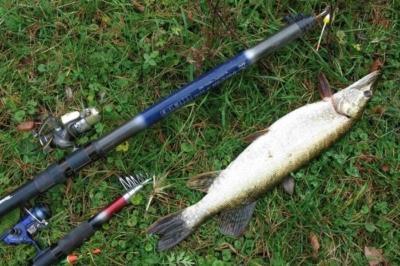
Blind installation using a swivel:
- At the end of the main fishing line, a swivel is knitted with a polomar knot.
- In addition, a weight leash 30-40 cm long with a drop-shot sinker is tied to the ring.
- A leash with an offset hook 120-150 cm long is knitted to another ring.
Blind installation using a triple swivel:
- At the end of the main line, a triple T-shaped swivel is tied to the top bar of the letter T.
- A leash with a hook 100-150 cm long is tied to another ring of the swivel on the top bar of the letter T.
- A leash with a sinker 25-40 cm long is tied to the lower ring.
Sliding
The most common installation option, used both in current and in still water.
This installation has advantages over solid installation:
- the fish does not feel the weight of the sinker when grabbing the bait;
- the bite is transferred directly to the main line without using a sinker;
- more versatile.
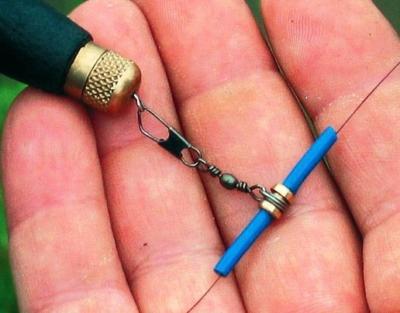
How to knit:
- A swivel is attached to the main line.
- Another swivel is tied at the end of the main line.
- A leash 60-150 cm long with a hook is tied to a freely moving swivel.
- A leash 30-50 cm long with a sinker is tied to the swivel at the end of the fishing line.
Horizon of bait retrieval with a drop-shot rig
I will dwell in more detail on the factors that highlight the features of the drop shot in relation to the popular Moscow equipment. In a drop shot, you can adjust the height of the bait in relation to the sinker, thereby determining the horizon of the retrieve when fishing vertically. Swimming into a hole where there is a fish, you can simply lower the drop-shot rig to the bottom and play on the spot.
This technique of fishing with a drop-shot rig was actually primary, and that is why this installation and the principle of fishing itself was called a sports term borrowed from tennis: “drop shot”.
The practice of using a drop shot shows that during even one fishing trip in the same area of a reservoir, it is sometimes necessary to consciously increase or decrease the distance between the hook and the sinker to increase fishing efficiency. There are many factors: the passivity and horizon of the fish, the structure of the bottom, the presence of a current, etc.
If fishing is done from the shore, then the angle between the fluorocarbon leader and the bottom of the reservoir depends on the casting distance and the steepness of the bottom rise. The minimum angle between the bottom and the plane (line) of the cord indicates that the bait will go in close proximity to the bottom. But even in this case, the greater the distance from the sinker to the bait, the more options available for animation of silicone baits (it will hover longer when paused, plus a wider range of movements and vibrations is available when the weight is resting in one place).
Fishing distance with drop shot and retractable leash
When using lead weights of the same weight, bait sizes and spinning rods of the same length, a drop-shot rig can be cast at quite comparable distances as a lead rig. However, due to the fact that the drop leader uses a smaller silicone bait than the drop shot, and the spinning rod for this setup is usually slightly longer than a specialized spinning rod for drop shot fishing, the drop leader usually flies a little further. But the justification for using this or that equipment will depend on the activity of the fish and its distance from the angler’s location.
Sometimes, in order to cast to the desired hole or “navel,” you have to sacrifice the size of the bait, which is one of the main factors influencing the casting distance, regardless of the type of installation. In this case, a compromise has to be made, which will result in smaller fish being caught.
How to fish: tactics and technique
Two basic provisions must be observed:
- the fishing line must be constantly taut;
- wiring should be slow.
On the current
Fishing on the outlet is more pragmatic in the current, since the current itself animates baits, including passive ones, which require animation by the angler’s hand in still water.
Additional animation is possible with slight vibrations of the rod tip:
- When fishing in the current, a sliding rig is used. You can cast the tackle upstream. This type of casting is practiced on slow-flowing rivers. Fishing by casting upstream does not provide any advantage, but sometimes dense vegetation on the bank does not allow casting the bait to the desired point in any other way.
- Casting downstream. When fishing in a strong current, it is better to cast the bait downstream. This significantly reduces the likelihood of the lines twisting, makes it possible to hold the bait at one point for a long time, while attracting the predator with an interesting game, and by gently shaking the tip of the rod, create additional seductive movements of the bait.
In still water
In still water there is no need to make adjustments to the equipment for the speed of the current, use sinkers of a certain shape, but the current will no longer animate the bait for the angler.
Expert opinion
Knipovich Nikolai Mikhailovich
Zoologist, hydrobiologist. I am interested in fishing at a professional level.
In still water, both sliding and blind installation can be used.
☸ Installation features
The retractable leash can be either sliding or blind, in addition, there are more complex variations with one triple or several single swivels. In its classic form, it is a piece of monofilament from a meter to one and a half long, tied to the main fishing line at a height of 40 cm above the sinker. This is a blind leash. In the sliding version, it moves on a swivel between the weight and the fastener. In complex designs, the leash slides on a certain section of the main line, not reaching the sinker. This is how a certain working height is achieved.
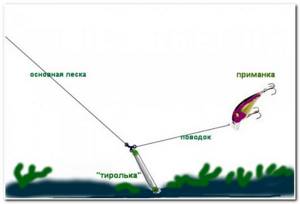
Since the retractable leash is primarily intended for catching unpretentious perch, it is usually made from a simple nylon fishing line, but no one forbids the use of fluorocarbon thread, which is invisible in the water. The best hook in such a rig would be an offset hook, which reduces the number of hooks to almost zero. Vibrotails and twisters are used as bait when fishing with a retractable leash. The sinker is selected by weight and shape, taking into account the flight range. Most often, anglers use:
- a cone-shaped bullet that prevents accidental snags;
- the so-called Tyrolean stick (a hollow tube with a plug at the end);
- pear-shaped sinker (on wide rivers and large lakes where long casting is required).
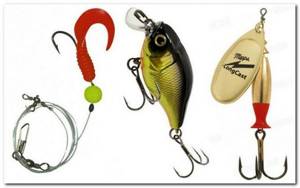
Lures for fishing
Silicone
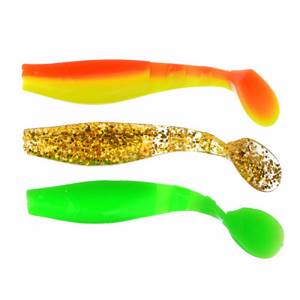
Attractive silicone baits - vibrating tails, twisters, slugs, creatures, crustaceans, etc., which were previously used in jig fishing with a sinker, are not burdened with excess weight when fishing with a lead, so their game is more natural and varied. This applies not only to silicone baits, but also to any other lightweight baits.
With a retractable leash, you can try any soft, light bait, both passive and active. It is difficult to predict which will work better under current conditions.
Traditionally, vibrating tails are considered the most universal because they respond well to:
- and perches;
- and pike;
- and bersh;
- and fanged.
At some point, picky perches may prefer dark-colored slugs, after a while the perch will want crustaceans, and pike and pike perch will rush to the slugs.
In addition to silicone baits, others may be the most attractive for a particular type of predator:
- soft foam baits;
- mandula;
- artificial insects, etc.
Wobblers
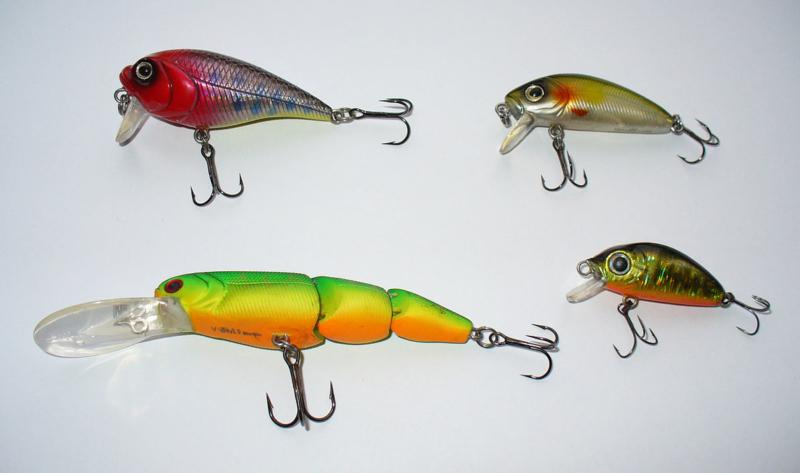
But in addition to soft baits, you can put wobblers on the “diverter” - suspenders or slowly pop-up ones. There are surface wobblers that turn out to be very catchy. On the outlet, they can be held near the bottom, providing them with an attractive game; perhaps this option will be even more catchy than fishing with silicone baits.
Other

In addition to wobblers made from artificial baits, the following are used:
- crawlers;
- frogs;
- mice.
You can experiment with any artificial bait that does not sink.
In addition to artificial ones, you can use natural baits:
- live bait;
- dead fish;
- pieces of fish;
- large insects;
- worms;
- larvae;
- leeches;
- Zhukov.
Sometimes even a pike weighing a kilogram is tempted by such baits.
Expert opinion
Knipovich Nikolai Mikhailovich
Zoologist, hydrobiologist. I am interested in fishing at a professional level.
If fishing is not just a means of obtaining food, but a serious hobby, it can be made even more attractive by including creativity in this process, using numerous experiments at each stage of the fishing business.
Fishing rod with retractable leash
When choosing a fishing rod with a retractable leader, you should first of all pay attention to such blank parameters as:
- build;
- length;
- test.
For cast-off fishing, a fast or ultra-fast action rod is suitable . Stiffer, ultra-fast blanks are primarily suitable for hunting pike and zander, which are better attracted by sharp jerky movements. If you plan to catch perch primarily, the spinning rod can be softer and have a fast action.
As for the length , when fishing for pike perch and pike, it is better if it is short: with a short spinning rod it is easier to carry out a sharp retrieve of the bait on a retractable leash. You can take a longer fishing rod for perch hunting.
The rod test is selected based on the weight of the baits to be used.
As a rule, when fishing with a retractable leash, fairly heavy loads are used (2-3 times the weight of the jig heads that would be needed for classic jig fishing under the same conditions).
How to catch predators: perch, pike perch, pike
Along with the general principles when catching predators on the outlet, for each species there are specific features in the installation of equipment and wiring, as well as in conventional spinning fishing.
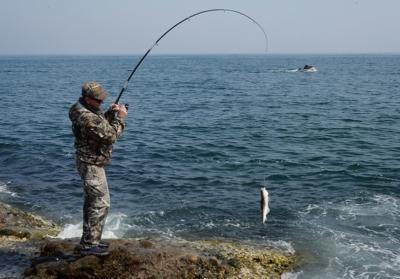
- For pike, braid is chosen as the main fishing line with a cross-section higher than usual - 0.16-0.2 mm; a steel string or a flexible Kevlar leash can be used as a leash for the bait.
You can take a risk and use a thick fluorocarbon leader material 0.28-0.35 mm, which, however, does not guarantee 100% safety from being bitten by sharp pike teeth. If fishing conditions allow, it is preferable to use double hooks rather than single hooks. - The pike perch does not have sharp teeth, but its mouth is very strong. Self-hooking will not be able to break through such a mouth. A low-stretch florocarbon leash is suitable for pike perch, but it is better to choose single hooks, they must be of the highest quality and perfectly sharpened. The hook should be sharp, short, strong.
- Perch, especially small ones, have weak lips. An extra jerk can damage them and the fish will fall off the hook. When fishing for perch, special attention must be paid to hooking and landing. The hook should be soft, not strong, and short. When fishing, you should loosen the clutch, do not jerk the fishing rod, lead the perch smoothly, without trying to lift it above the water while fishing.
Fishing success largely depends on fishing in still water. There are general recommendations for each type of fish, but following them unconditionally, regardless of the circumstances, is not recommended. The recommendations are good for starting fishing.
- For example, perch loves a calm, smooth, slow retrieve with low-amplitude, high-frequency vibrations with the tip of the rod.
- Pike and pike perch prefer jerky, aggressive fishing with sharp twitches and pauses.
If there is no bite, you need to experiment with both equipment and wiring.
Fishing with a “divert” gained popularity in Russia not so long ago , but every year it finds more and more fans. Fishermen are mobile and dynamic people, they try not to miss new trends in fishing, especially since they could not help but fall for such a catchy method.
Differences in fishing with a drop shot and a retractable leash
For a retractable leash, both sinking and floating silicone baits can be used. At the same time, for their active animation it is necessary to tap the weight, that is, the entire equipment on the bottom. Otherwise, a twister or any other active bait may simply not start if, for example, you try to carefully animate it without moving the weight from its place. Micromovements of the bait will also occur when the load is at rest, but its tail part will no longer work effectively.
The distinctive feature of the drop shot is its spot fishing. This equipment becomes highly effective when a passive fish is standing on some local spot and can only be stirred up by animating the bait literally in one place (jerking with the tip of the spinning rod and pulling the cord without lifting the sinker from the bottom). But if you need to throw a silicone bait into a clearing in a densely overgrown area with grass, under a snag, branches overhanging the water, and stop at the exit from the hole, the bottom of a dump or a “navel,” then the best bottom equipment will again be a drop shot (especially if the above requirements refer to a body of water with a current).
Methodical animation with edible rubber in one place with long pauses can be replaced by active powerful jerks of the spinning rod with active tapping of the sinker on the bottom. The determining factor in the choice of wiring will be, as in the case of other spinning baits, the degree of passivity of the fish.
Spinning rods for drop-shot and retractable leash
Some American and Japanese manufacturers of spinning rods produce spinning rods specifically for drop-shot fishing. For example, G. Loomis DSR 820 S 6'1, NRX 822S DSR 6'1 and Nories Structure ST650M. Such spinning rods are, first of all, characterized by high sensitivity, power, reliability, fast action and short length. But in an effort to optimally combine all of the listed characteristics, manufacturers began serial production of one-piece spinning rods.
For this trivial reason, it is not easy to find a specialized spinning rod for drop-shots in the more familiar two-part design on the Russian market. Although, in general, short two-piece bass spinning rods with a length of up to 7 feet and a top test not exceeding 1 ounce are also quite suitable for drop shots. In floodplain areas of rivers where there is no current, I like to fish with a very delicate stick with dough up to 7 grams (with weights up to 5 grams and baits up to 2 inches).
On large rivers with strong currents (Moscow, Oka, Volga rivers) you should use a more powerful spinning rod with a dough weight of up to 28 g or more. As a rule, when installing heavier weights on a drop-shot rig, I also enlarge the size of the lures. But for a retractable leash, in my opinion, a long and not very rigid (with a slower action) spinning rod would be preferable. The large length is due to the comfortable casting of equipment, where the length of the leash can reach up to 1.5 meters.
And the slower action of the spinning rod, compared to the “stakes” for a drop shot, allows for effective dynamic retrieve. Although my friends who use short spinning rods of about 7 feet for a retractable leash also catch perch quite successfully. But these are rather specific preferences for such spinning rods, rather than a general trend. The advantages of using short spinning rods include: the light weight of the spinning rod kit, which is comfortable to fish for a long time; the emergence of more options for jerk wiring. The disadvantages are a reduction in casting range.
Accessories for mounting drop-shot equipment
There are no fundamental differences in the requirements for fittings between the two equipment under consideration. Lead weights are the same in shape, weight and type. But their shape can often vary, for example, depending on the preferences of the fisherman or fishing conditions (minimizing hooks). These can be “bells”, “sticks”, “all-terrain vehicles”, etc. They should be united by one feature - fastening the fishing line using the quick release principle. Such sinkers will be cut off when hooked, only very slightly shortening the fluorocarbon leader.
Saving significant time (since we don’t have to re-tie the entire equipment), we simply attach a new sinker and continue fishing. For effective drop-shot fishing, in addition to different types of baits, hooks and fluorocarbon for leashes must be correctly selected. The choice of fluorocarbon will depend on the weight of the lead weight used and the fishing conditions. For lead weights weighing 3.5 g and 5 g, you can use Daiwa TD Line Ades 0.13 mm, for weights 10–18 g Daiwa TD Line Fluoro 0.195 mm, respectively.
When fishing with a drop shot in snags in water bodies and in the middle of small clearings of dense, dense grass, the use of fluorocarbon leashes up to 0.25 mm thick will be quite justified. Special hooks for drop-shot fishing are primarily wide hooks with a short shank. This form fits optimally into the “logic” of installation, as it allows you to keep the body of the bait in close proximity to the leash, make the hook less noticeable, and make the equipment compact.
This shape of the hook allows you to completely hide the hook in the head of the silicone bait, and at the same time slightly open the sting. The short length of the hook allows you to include (vibrate) an additional part of the body of the worm or slug and increases the effectiveness of grips in cases where a significant number of them fall on the head part of the bait.
For worms and narrow-bodied slugs like Ecogear Sansun 3 (inches), I use small hooks Vanfook Devil Down Shot Single No. 9. For wider and more massive baits, for example, Ecogear Minnow M 4, Vanfook Devil Down Shot Single No. 2 is ideal. In situations , when you need to fish in areas overgrown with underwater grass, with snags, numerous branches and other bottom obstacles, there is an objective need to use Vanfook Devil Down Shot Single Weedless hooks (photo 6). Their design includes an additional element - antennae made of dense wire. These tendrils extend away from the eye of the hook and prevent the bait (including the hook) from catching. The correct knot that secures the hook to the fluorocarbon leader is also of great importance (photos 7 and 8).
}The hook should be positioned at right angles to the leash and not slide along it. It is enough to know several knots in order to choose the best option for yourself by using (selecting) each one: - “strongly twisted” (palomar knot); — “dropper loop”; - universal (trilene knot). American anglers have the opinion that the Palomar holds a knot better with thicker fluorocarbon lines, and with 4-8 pound lines this knot loses a lot of strength and breaks easily. But the “dropper loop” is more preferable for me.
However, no matter what knot is used, I recommend periodically tying the equipment to avoid shooting during casting and breakages even on a relatively flat bottom (especially after landing a large fish or pulling out a large snag). To summarize, I would like to emphasize that the diverter leash rig requires a larger number of fittings for mounting the rig than a drop shot. These can be swivels, carabiners, and other elements that optimize the behavior of the bait at the end of the leash.
In addition, the consumption of fluorocarbon will always be higher. In this regard, the drop shot is a less expensive and economical equipment. I cannot help but note that on a retractable leash, when fishing with twisters with soft and elastic tails, as well as with various variations of thin-tailed slugs, the bait, even after one retrieving cycle, often returns without a tail. When fishing with a drop shot, such precedents practically do not occur, since “passive” baits (with a body and tail) made of rubber with a denser composition are more often used.
Methods for attaching a leash
There are several options for attaching the leash to the equipment. For example:
- Using the “loop-to-loop” method. A loop is formed at the end of the leash, which is threaded through the loop on the main fishing line, after which a hook is threaded into the same loop. Finally, the connection is tightened. The disadvantage of this option is the fact that it is impossible to quickly change the leash. Despite this, there are no problems with removing the leash.
- Attaching the leash using a swivel. This method allows you to minimize overlaps.
- Fastening the leash using a clasp (carabiner). This is the most progressive option, allowing you to easily change the leash to a new one, since very often you have to experiment.
And here's what you need to know: Rating of the best spinning rods for fishing
